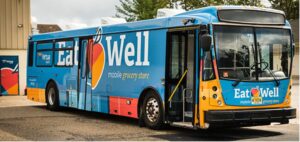Reaching the Community: Sustainability in Population Health
Healthcare's focus is improving population health. Food and Nutrition Services can play a role in driving population health initiatives


By: Lisa Roberson, RDN, LD, Corporate Director of Wellness, Morrison Healthcare
Healthcare is about taking care of people. Not just inside our facilities but in the surrounding community. That’s where population health comes in. It’s more than a buzzword. It is a rallying cry for hospital administrations looking to extend their influence and impact the world around them. Food and Nutrition Services departments can play an important role in making that happen and driving population health initiatives.
I recently wrote an article for Provider magazine about 4 Strategies to Bring Population Health to Your Food and Nutrition Services Program The piece is focused on skilled nursing and long-term care facilities, but there are a number of takeaways that can be useful for hospital administrators, regardless of facility size. Let’s take a look at two of them and expand with some specifics about how Morrison Healthcare is impacting population health.
Think Beyond the 4 Hospital Walls
We do an excellent job of caring for patients inside the hospital, but there are often health challenges in the greater community. How do we create sustainable healthy eating habits beyond the hospital’s four walls? It takes education and a programmatic approach.

We have partnered with many hospitals across the country to create programs that drive wellness for entire populations. Look at what is happening at Virtua Health in southern New Jersey. The health system created a mobile grocery delivery program called Eat Well Mobile Grocery Store. With a converted public transportation bus, dietitians deliver healthy food options (sold at cost) to areas that have been identified as food deserts.
Well-conceived and implemented, the program’s success is rooted in community outreach. Virtua Health started with surveys and conversations with the affected populations in Burlington and Camden Counties. Not only did they educate their audience, but they also listened and gained key insights that helped to make the program successful.
This is only one example. We have partnered with Spartanburg Regional Health System to address food insecurity. And worked with UVA Health to create a program to address food insecurity.
There is not a one-size-fits all program for population health initiatives. But successful programs do have one common theme—they look beyond the care provided in the hospital and find ways to implement sustainable wellness habits in the community.
Reduce Waste
Approximately 40 percent of food produced in the U.S. is wasted. That presents a challenge and an opportunity. Controlling food waste makes you a better steward of your resources and helps to manage your business in a sustainable way.
Our Waste Not 2.0 tool leverages technology and analytics using a tablet to track and record food waste types, amounts and ultimate destination (e.g., donation, composting, and landfill). Through this data, hospitals receive valuable insights to create new strategies and address stopping food waste at the source.
Since Waste Not 2.0 was created, hospitals who have adopted the program have seen food waste reductions as much as 50 percent. That can have a significant impact on food costs. Beyond the finances, MHC has seen increases in employee engagement coupled with Waste Not 2.0. Associates like to feel good about the work they are doing. The program empowers them to make a difference at their facility and within the community.
Hospitals have an opportunity to move the needle for entire communities. By taking a comprehensive look at a community’s health needs, we can work together to create healthier patients and healthier populations. It starts with sustainable wellness initiatives on the local level. From there, we will create a movement that drives results and changes lives.








